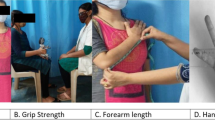Abstract
Purpose
The objective of this study was to examine the influence of anthropometric data, occupational manual strain, DASH (disability of arm, shoulder and hand) score and range of motion (ROM) on grip strength and key pinch. An additional goal was to develop models that enable the prediction of hand strength using the aforementioned parameters.
Methods
Normative data generated from a healthy working population (n = 750) served as basis for the statistical analysis. Prediction models for hand strength were developed using multivariate regression analysis.
Results
Gender, body weight and height, BMI and extension ROM correlate positively, age and DASH score, however, correlate negatively with grip strength and key pinch. Occupational manual strain has no influence on hand strength. The predictive power of the developed models was 68.4 % for grip strength and 57.1 % for key pinch.
Conclusions
The developed models enable the prediction of hand strength using easily obtainable data points. The models will have application in clinical practice, physiological studies, medical evidence and rehab decisions.


Similar content being viewed by others
References
Goodson A, McGregor AH, Douglas J, Taylor P (2007) Direct, quantitative clinical assessment of hand function: usefulness and reproducibility. Man Ther 12:144–152
Klum M, Wolf MB, Hahn P, Lelcère FM, Bruckner T, Unglaub F (2012) Normative data on wrist function. J Hand Surg Am [Epub ahead of print]
Bohannon RW, Peolsson A, Massy-Westropp N, Desrosiers J, Bear-Lehman J (2006) Reference values for adult grip strength measured with Jamar dynamometer: a descriptive meta-analysis. Physiotherapy 92:11–15
Vaz M, Hunsberger S, Diffey B (2002) Prediction equations forehand grip strength in healthy Indian male and female subjects encompassing a wide age range. Ann Hum Biol 29:131–141
Angst F, Drerup S, Werle S, Herren DB, Simmen BR, Goldhahn J (2010) Prediction of grip and key pinch strength in 978 healthy subjects. BMC Musculoskelet Disord 11:94
Chandresakaran B, Ghosh A, Prasad C, Krishnan K, Chandrasharma B (2010) Age and anthropometric traits predict handgrip strength in healthy adults. J Hand Microsurg 2:58–61
Hossain MG, Zyroul R, Pereira BP, Kamarul T (2012) Multiple regression analysis of factors influencing dominant hand grip strength in an adult Malaysian population. J Hand Surg Eur 37(1):65–70
Hanten WP, Chen WY, Austin AA, Brooks RE, Carter HC, Law CA, Morgan MK, Sanders DJ, Swan CA, Vanderslice AL (1999) Maximum grip strength in normal subjects from 20–64 years of age. J Hand Ther 12:193–200
Massy-Westropp N, Rankin W, Ahern M, Krishnan J, Hearn TC (2004) Measuring grip strength in normal adults: reference ranges and a comparison of electronic and hydraulic instruments. J Hand Surg Am 29:514–519
Fess EE (1992) Grip Strength. In: Casanova JS (ed) Clinical assessment recommendations, 2nd edn. American Society of Hand Therapists, Chicago, pp 41–45
Balogun JA, Akomolafe CT, Amusa LO (1991) Grip strength: effects of testing posture and elbow position. Arch Phys Med Rehabil 72:280–283
Mathiowetz V, Weber K, Volland G, Kashman N (1984) Reliability and validity of grip and pinch strength evaluations. J Hand Surg Am 9:222–226
Firrell JC, Crain GM (1996) Which setting of the dynamometer provides maximal grip strength? J Hand Surg Am 21:397–401
Mathiowetz V, Rennells C, Donahoe L (1985) Effect oft elbow position on grip and key pinch strength. J Hand Surg Am 10:694–697
Günther CM, Bürger A, Rickert M, Schulz CU (2008) Key pinch in healthy adults: normative values. J Hand Surg Eur 33:144–148
Ruby LK, Cooney WP, An KN (1988) Relative motions of the selected carpal bones: kinematic analysis of the normal wrist. J Hand Surg Am 12:1–10
MacDermid J, Kramer J, Woodbury M, McFarlane R, Roth J (1994) Interrater reliability of pinch and grip strength measurements in patients with cumulative trauma disorders. J Hand Ther 7:10–14
Haidar SG, Kumar D, Bassi RS, Deshmukh SC (2004) Average versus maximum grip strength: which is more consistent? J Hand Surg Eur 29:82–84
Coldham F, Lewis J, Lee H (2006) The reliability of one versus three trials in symptomatic and asymptomatic subjects. J Hand Ther 19:318–327
Hudak PL, Amadio PC, Bombardier C (1996) Development of an upper extremity outcome measure: the DASH (disabilities of the arm, shoulder and hand). The Upper Extremity Collaborative Group. Am J Ind Med 29(6):602–608
Ugurlu Ü, Özdogan H (2012) Age- and gender-specific normative data of pinch strengths in a healthy Turkish population. J Hand Surg Eur 37(5):436–446
Bot AG, Mulders MA, Fostvedt S, Ring D (2012) Determinants of grip strength in healthy subjects compared to that in patients recovering from a distal radius fracture. J Hand Surg Am 37(9):1874–1880
Xu S, Morse AM, Lacy B, Baggett LS, Gogola GR (2011) Peg restrained intrinsic muscle evaluator (PRIME): development, reliability, and normative values of a device to quantify intrinsic hand muscle strength in children. J Hand Surg Am 36(5):894–903
Crosby CA, Wehbe MA (1994) Hand strength: normative values. J Hand Surg Am 19:665–670
Fraser A, Vallow J, Preston A, Cooper G (1999) Predicting “normal” grip strength for rheumatoid arthritis patients. Rheumatology 38:521–528
Mitsionis G, Pakos EE, Stafilas KS, Paschos N, Papakostas T, Beris AE (2009) Normative data on hand grip strength in a Greek adult population. Int Orthop 33:713–717
Puh U (2010) Age-related and sex-related differences in hand and pinch grip strength in adults. Int J Rehabil Res 33:4–11
Günther CM, Bürger A, Rickert M, Crispin A, Schulz CU (2008) Grip strength in healthy Caucasian adults: reference values. J Hand Surg Am 33:558–565
Iwasaki N, Nishida K, Motomiya M, Funakoshi T, Minami A (2011) Arthroscopic-assisted repair of avulsed triangular fibrocartilage complex to the fovea of the ulnar head: a 2- to 4-year follow-up study. Arthroscopy 27(10):1371–1378
Furia JP (2010) Arthroscopic debridement and synovectomy for treating basal joint arthritis. Arthroscopy 26(1):34–40
Hohendorff B, Mühldorfer-Fodor M, Kalb K, van Schoonhoven J, Prommersberger KJ (2012) STT arthrodesis versus proximal row carpectomy for Lichtman stage IIIB Kienböck’s disease: first results of an ongoing observational study. Arch Orthop Trauma Surg
Prommersberger KJ, Pillukat T, Mühldorfer M, van Schoonhoven J (2012) Malunion of the distal radius. Arch Orthop Trauma Surg 132(5):693–702
Conflict of interest
The authors have no conflict of interest.
Author information
Authors and Affiliations
Corresponding author
Rights and permissions
About this article
Cite this article
Klum, M., Wolf, M.B., Hahn, P. et al. Predicting grip strength and key pinch using anthropometric data, DASH questionnaire and wrist range of motion. Arch Orthop Trauma Surg 132, 1807–1811 (2012). https://doi.org/10.1007/s00402-012-1602-8
Received:
Published:
Issue Date:
DOI: https://doi.org/10.1007/s00402-012-1602-8




